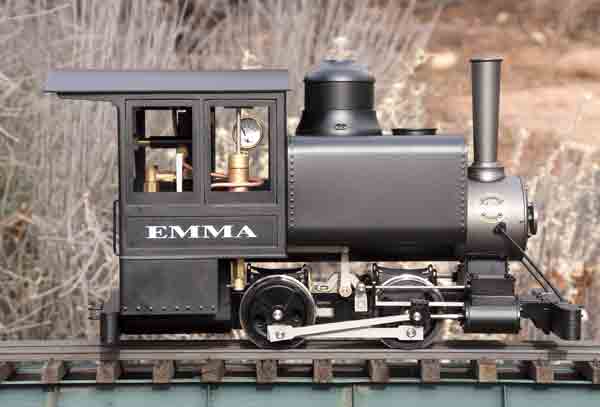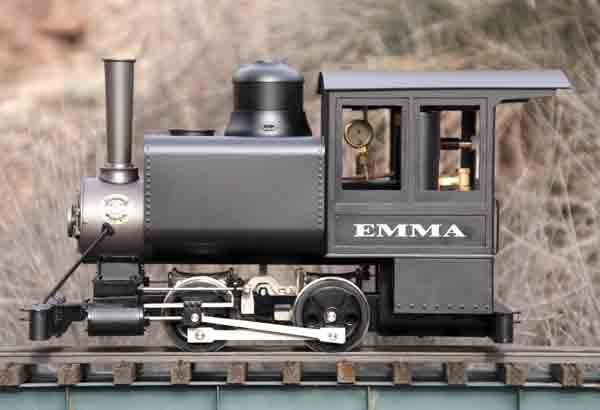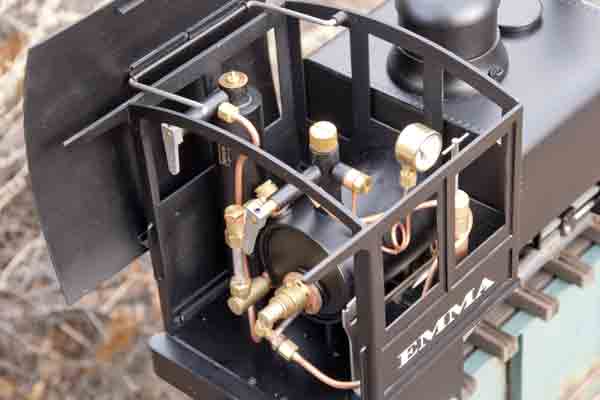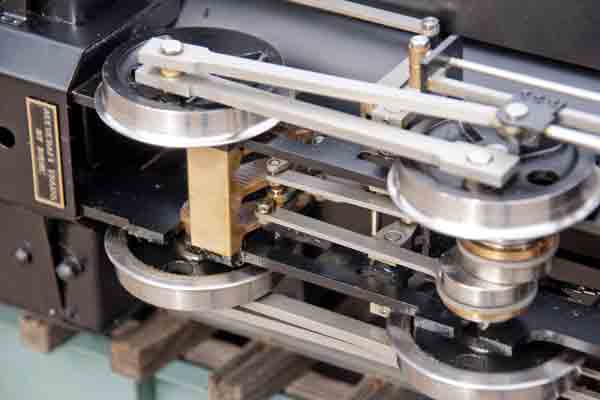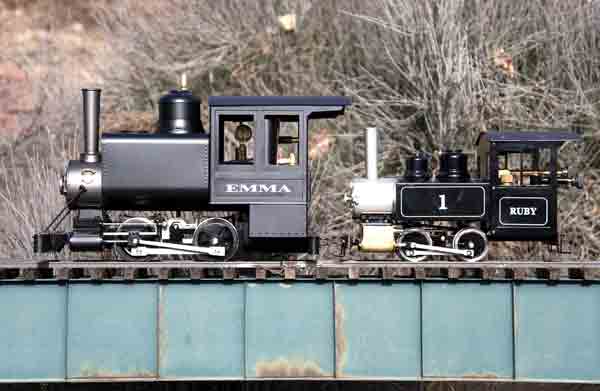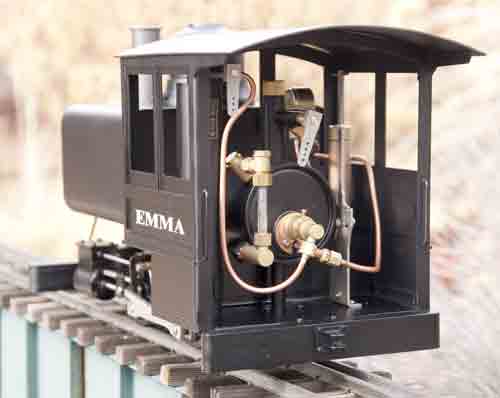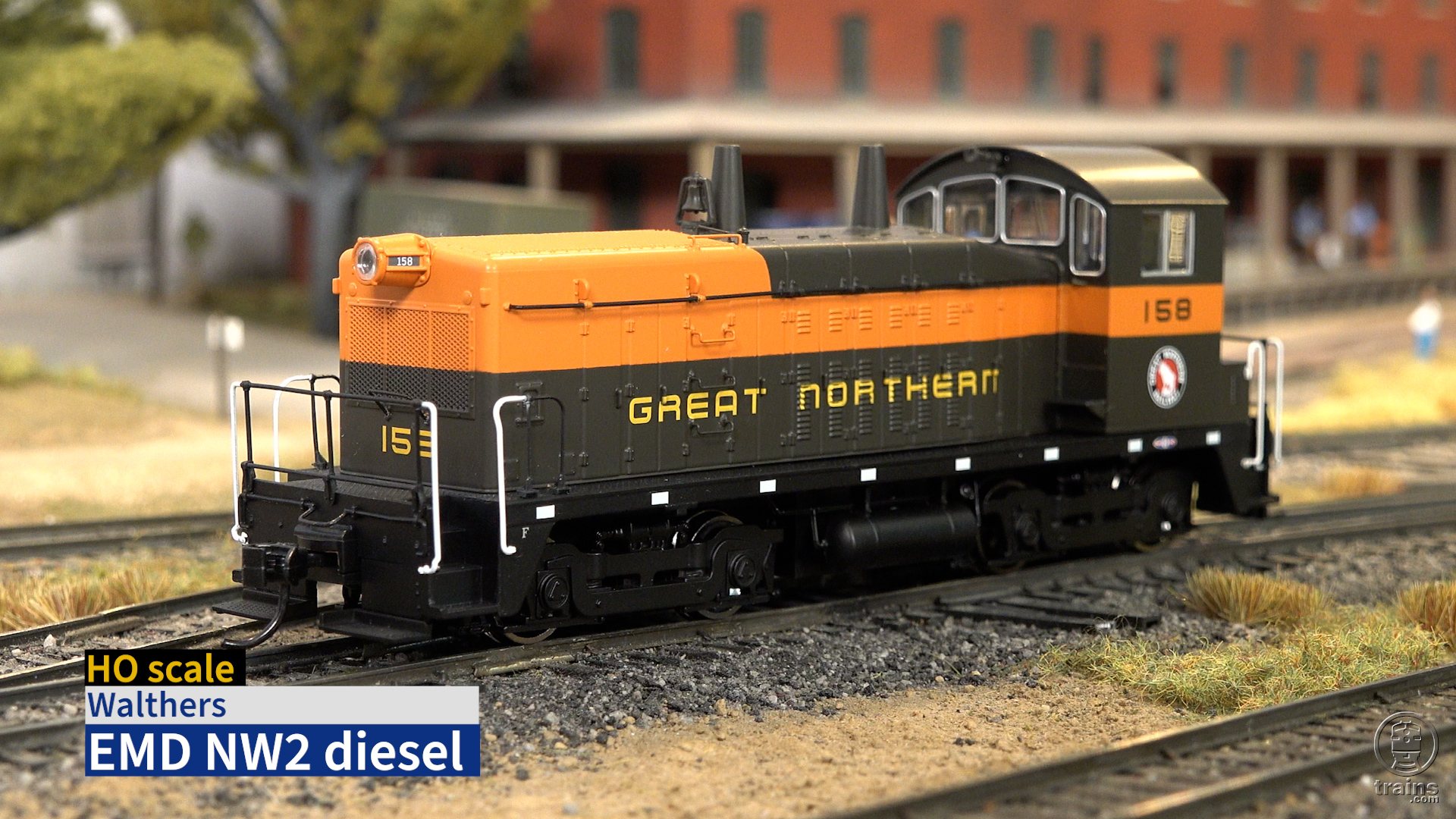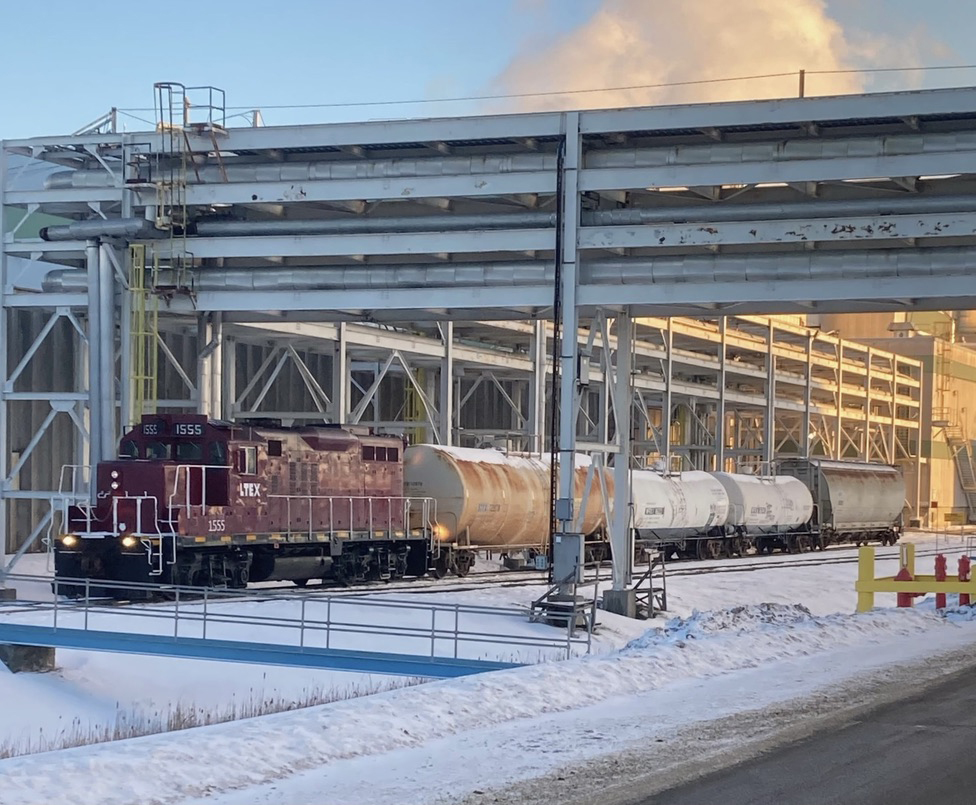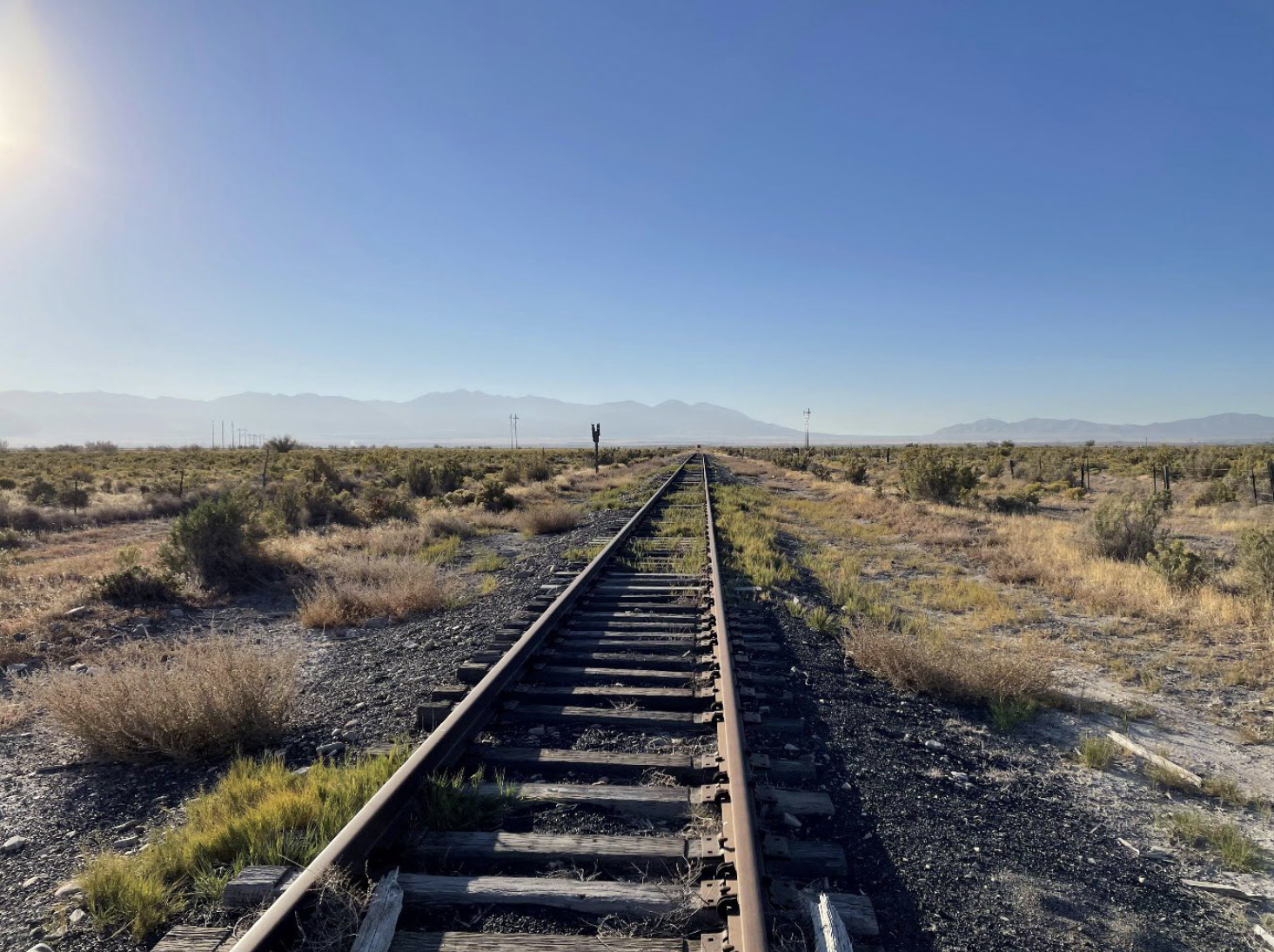Accucraft Trains
33268 Central Ave.
Union City CA 94587
Price: $995
Website: http://accucraft.com
1:13.7 scale, live-steam 0-4-0T; gas fired; reversing from the cab via simple eccentrics and reversing links between the frames; D-valves; displacement lubricator; water glass; safety valve; pressure gauge; throttle; superheater; 60 psi blowoff pressure; some tools and syringes included; instruction booklet. Dimensions: Length over end beams, 11 ¾”; width, 5 3/8″; height over stack, 7 3/8″. In 1:13.7 scale, this works out to 13’5″ x 6’1½” x 8’5″, respectively. Weight: 11 pounds
Pros: Accurate scale model; high level of detail; excellent paint and graphics; easy access to controls; prototypical wheel thickness; superheater; excellent running characteristics; relatively quiet burner; distinct, audible exhaust beats; good slow-speed control; long duration
Cons: Safety valve not easily accessible; R/C may be difficult
Accucraft’s Emma is a model of a Brooks 0-4-0T. Brooks Locomotive Works, of Dunkirk, New York, was founded in 1869 and, for many years, was an important supplier of locomotives to railroads and industry. The company fell on hard times and, in 1901, merged with several other locomotive builders to become the American Locomotive Company, or ALCO.
Accucraft’s model depicts a smaller example of Brooks’ output, representing a tiny industrial 0-4-0T with an open cab and a distinctive rectangular saddle tank surmounted by a large steam dome. Without anything for scale reference, the engine appears to be roughly the size and proportion of Accucraft’s Ruby. However, the size (and scale) difference is readily apparent when the two locomotives are placed side by side. Emma is a chunk!
The engine arrived packed in Accucraft’s usual superb way. In the box was the engine, an instruction booklet, a pair of syringes (one for water, one for steam oil), an Allen wrench, an open hex wrench, the dummy whistle (to be screwed into the dome), some extra screws and nuts, an extra glass tube for the sight glass, and a pair of driving gloves for hands smaller than mine.
Emma differs from Ruby in many significant ways. It is a much more sophisticated locomotive, featuring D-valve cylinders, a proper pop-type safety valve, higher working pressure (60 psi), and a water glass and pressure gauge.
The boiler is a traditional single-flue design, gas fired, but with the added bonus of a superheater pipe through the flue. This appears to be made of stainless steel. The smokebox door is hinged and kept closed with a spring clip. There’s a capacious vertical gas tank in the cab to the left of the boiler. For filling, the roof lifts out of the way on a hinge. The backhead is neatly laid out, with the water glass, gas valve, and throttle close at hand. The pressure gauge is mounted forward somewhat and faces out a right-side window behind the lubricator. I’m not crazy about this position. However, it wouldn’t take much to relocate the gauge so that it’s closer to the backhead and aimed out the rear.
As mentioned above, the engine has D-valve cylinders. These are controlled with simple eccentrics, unusually mounted on the front axle. Reversing is accomplished via reversing links between the frames, with radius rods controlled by a lever in the cab. Rocker arms bring the motion through the frames to the valves.
The large, rectangular saddle tank is a dummy. An enterprising modeler might be able to make it functional, though room would have to be found for a hand pump somewhere—difficult but not impossible. The safety valve is hidden under the dome and, unfortunately, is not readily accessible. To get at it, you must remove the entire saddle tank. This is accomplished by unscrewing the dummy water hatch atop the tank, then simply lifting off the tank and dome assembly, revealing the safety valve. It would have been nice to just have a lift-off dome, but this is a small matter.
One of my pet peeves with many scratchbuilt 7∕8″ models that I’ve seen is the thinness of the wheel profile. This is a result of using smaller-scale wheels for a larger-scale model—the wheel thickness doesn’t scale up and is a dead giveaway. Not so with Emma, whose wheels are prototypically fat, with a nice flange profile. The engine’s rods are also robust, having been machined from the solid, not stamped from sheet. The frames are plate, with cutouts to make them resemble American-style bar frames.
Though a simple engine, the detail level is relatively high, with full rivet detail around the tank and at the base of the cab. Large, etched-brass builder’s plates adorn either side of the smokebox. However, the works number on the plates (Nº 2475) belongs to a 2-6-0. The date (1894) may also be incorrect but no hard information as to the prototype’s date is available. Front and rear beams are metal, representing wood, with etched-in wood grain. Couplers are the same simple link-and-pins supplied with some of Accucraft’s smaller-scale engines and they’re also at the same height, which may prove problematic. For instance, they do not match, height-wise, Sierra Valley’s 7∕8″ scale Munger Mining stock. However, the height does appear correct when compared to drawings that appeared in the April 1982 1:22.5 Digest.
I prepared Emma for a test run by first oiling all moving parts with a lightweight machine oil, then filling the displacement lubricator with steam oil and the boiler with distilled water to within around
1∕8″ of the top of the glass. I then filled the tank with butane gas using an adaptor (not supplied). Test-run day was sunny but cool, with the temperature around 45°F.
The fire lit easily and flashed back into the flue. The superheater pipe was soon glowing red. The burner is relatively quiet, given the size of the engine, which was a pleasant surprise. It took a good 10 minutes or more for the boiler to come up to working pressure. Once that was attained, I opened the throttle, gave the engine a couple of encouraging nudges to clear the cylinders, and it was off and running.
Speed control on this engine is excellent. With 60 psi on the clock, it can be throttled down to a crawl, with the exhaust beats clearly audible, even running light. Top speed is pretty brisk but there’s no reason to go there—the engine is quite responsive to the throttle at any speed.
Emma ran smoothly in both directions. Because of the relatively large boiler and gas tank, the duration of the run is nice and long. I confess that I got cold after about 30 minutes, and I shut the engine down, still with gas and water in it. Indoors, a 45-minute run was achieved.
I am quite impressed with this locomotive. While it is a fairly sophisticated engine, it is simple enough to operate that a beginner should have good success with it. I have always found 7∕8″ scale attractive and it is a well-known phenomenon that the larger the model is in scale, the better it conveys the sense of the prototype. Watching Emma run was more like watching a small, full-size locomotive than watching a model. An engine of this size and bulk has real presence and its loud exhaust beats and slow-speed performance make it that much more prototypical. If you’re interested in 7∕8″ scale or are just a fan of small steam locomotives, take a look at this one. In my opinion, Accucraft has hit a home run with Emma.





